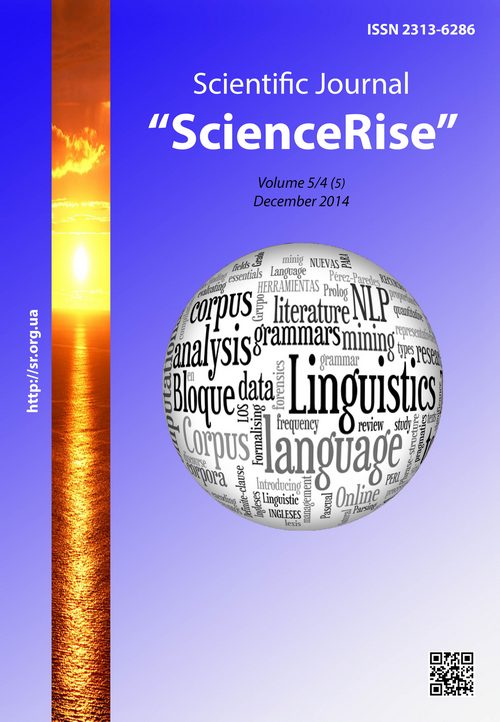About a mechanism of the influence of shear stress for viscosity of the blood in vessels of small diameter
DOI:
https://doi.org/10.15587/2313-8416.2014.35085Keywords:
sigma-effect, viscosity, erythrocytes, deformability, water pores, shear stressAbstract
It is proposed a physiological and experimentally confirmed explanation of Fåhraeus-Lindqvist-effect in capillaries using the profile analyses of osmotic deformability of red blood cells. It was shown the dose-dependent change of the erythrocytes deformability in the stage of isotropic spheres after forming artificial water pores (nystatin) and occlusion (PbCl2) of available pores. The Sigma-effect reducing of hematocrit and viscosity in a shear flow of blood through the vessels of a small diameter was conditioned by the interchange of liquid phase between the erythrocyte and the plasma.
References
Fåhraeus, R., Lindqvist, T. (1931). The viscosity of the blood in narrow capillary tubes. Am. J. Physiol., 96, 562–568.
Medvedev, A. E. (2013). Dvuhfaznaja model' techenija krovi. Rossijskij zhurnal biomehaniki, 17, 4 (62), 22–36.
Moyers-Gonzalez, M., Owens, R. G., Fang, J. (2008). A non-homogeneous constitutive model for human blood. Part. 1. Model derivation and steady flow. Journal of Fluid Mechanics, 617, 327–453. doi: 10.1017/s002211200800428x
Pries, A. R., Secomb, T. W.; Tuma, R. F., Dura, W. N., Ley, K. (Eds.) (2008). Blood Flow in Microvascular Networks. In: Handbook of Physiology: Microcirculation. Аcademic Press, 3–36. doi: 10.1016/b978-0-12-374530-9.00001-2
Sharan, M., Popel, A. S. (2001). A two-phase model for flow of blood in narrow tubes with increased effective viscosity near the wall. Biorheology, 38, 415–428.
Ponomarenko, G. N., Turkovskij, I. I. (2006). Biofizicheskie osnovy fizioterapii. Moscow: Medicine, 176.
Huo, Y., Kassab, G. S. (2009). Effect of compliance and hematocrit on wall shear stress in a model of the entire coronary arterial tree. Journal of Applied Physiology, 107 (2), 500–505. doi: 10.1152/japplphysiol.91013.2008
Xue, X., Patel, M. K., Kersaudy-Kerhoas, M., Bailey, C., Desmulliez, M. P. (2011). Modelling and simulation of the behaviour of a biofluid in a microchannel biochip separator. Computer Methods in Biomechanics and Biomedical Engineering, 14 (6), 549–560. doi: 10.1080/10255842.2010.485570
Johnson, R. M. (1989). Ektacytometry of red blood cells. Methods in Enzymology, 173 (T), 35–54. doi: 10.1016/s0076-6879(89)73004-4
Charm, S. E., Kurland, G. S. (1972). Blood Rheology. In: Cardiovascular fluid dynamics. Vol. 2. Acad. press, London & New York, 202.
Schmid-Schönbein, H. (1981). Factors promoting and preventing the fluidity of blood. Microcirculation. Current physiologic, medical, and surgical concepts. Acad press: N. Y., London, Toronto, Sydney, San-Francisco, 317.
Tsai, S. T., Zhang, R. B., Verkman, A. S. (1991). High channel-mediated water permeability in rabbit erythrocytes: characterization in native cells and expression in Xenopus oocytes. Biochemistry, 30, 2087–2092. doi: 10.1021/bi00222a013
Katsu, T., Okada, S., Imamura, T., Komagoe, K., Masuda, K., Inoue, T., Nakao, S. (2008). Precise size determination of amphotericin B and nystatin channels formed in erythrocyte and liposomal membranes based on osmotic protection experiments. Analytical Sciences, 24 (12), 1551–1556. doi: 10.2116/analsci.24.1551
Ivens, I., Skejlak, R. (1982). Mehanika i termodinamika biologicheskih membran. Moscow: Mir, 304.
Clarc, M. R., Mohandas, N., Shohet, S. B. (1983). Osmotic gradient ektacytometry: comprehensive characterization of red cell volume and surface maintenance. Blood, 61 (5), 899–910.
Bossi, D., Russo, M. (1996). Hemolytic anemias due to disorders of red cell membrane skeleton. Molecular Aspects of Medicine, 17 (2), 171–188. doi: 10.1016/0098-2997(96)88346-4
Johnson, R. M., Ravindranath, Y. (1996). Osmotic scan ektacytometry in clinical diagnosis. Journal of Pediatric Hematology/Oncology, 18 (2), 122–129. doi: 10.1097/00043426-199605000-00005
Streekstra, G. J., Dobbe, J. G., Hoekstra, A. G. (2010). Quantification of the fraction poorly deformable red blood cells using ektacytometry. Optics Express, 18 (13), 14173–14182. doi: 10.1364/oe.18.014173
Tillmann, W. (1986). Reduced deformability of erythrocytes as a common denominator of hemolytic anemias. Wien. Med. Wochenschr., 136, 14–16.
Downloads
Published
Issue
Section
License
Copyright (c) 2014 Лев Николаевич Катюхин

This work is licensed under a Creative Commons Attribution 4.0 International License.
Our journal abides by the Creative Commons CC BY copyright rights and permissions for open access journals.
Authors, who are published in this journal, agree to the following conditions:
1. The authors reserve the right to authorship of the work and pass the first publication right of this work to the journal under the terms of a Creative Commons CC BY, which allows others to freely distribute the published research with the obligatory reference to the authors of the original work and the first publication of the work in this journal.
2. The authors have the right to conclude separate supplement agreements that relate to non-exclusive work distribution in the form in which it has been published by the journal (for example, to upload the work to the online storage of the journal or publish it as part of a monograph), provided that the reference to the first publication of the work in this journal is included.

